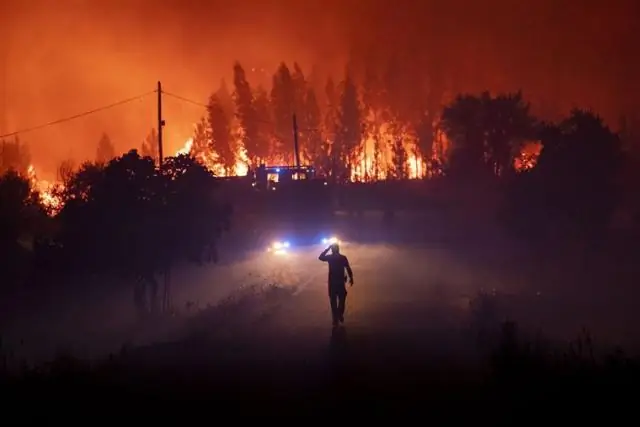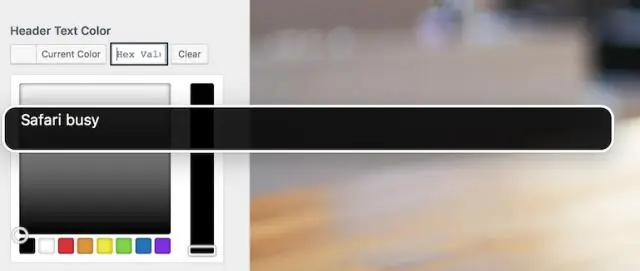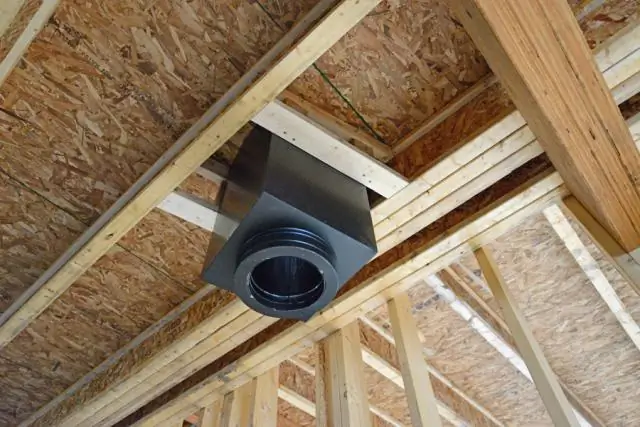
Table of contents:
- Steel pipe chimney - do it yourself
- What is a chimney and how does it work
- What materials are they made of
- Varieties of steel structures
- Types of materials
- The design of a two-layer chimney and its distinctive features
- Making a sandwich chimney with your own hands
- Features of the use of sandwich pipes for a bath
- Operation, repair and cleaning
- Author Bailey Albertson [email protected].
- Public 2023-12-17 12:53.
- Last modified 2025-01-23 12:41.
Steel pipe chimney - do it yourself

All efforts to equip your country house can literally fly out into the pipe if this very pipe is poorly designed and made. Reverse thrust will provoke smoke and waste. Or the elements of the roof will get hot, causing a fire. The efficiency of your stove or boiler depends on the chimney. Therefore, you need to understand well the structure of the steel chimney and competently approach its manufacture with your own hands.
Content
- 1 What is a chimney and how does it work
-
2 What materials are made of
- 2.1 Brick
-
2.2 Pipes
- 2.2.1 Asbestos-cement pipes
- 2.2.2 Ceramic
- 2.2.3 Glass
- 2.2.4 Polymer
- 2.2.5 Steel
-
3 Varieties of steel structures
- 3.1 Direct chimneys
- 3.2 Side tie-downs
- 3.3 Lateral inner
-
4 Types of materials
- 4.1 Black Steel
- 4.2 Low alloy steel
- 4.3 Galvanized iron
-
4.4 Stainless steel
- 4.4.1 Corrugated steel pipes
- 4.4.2 Single wall stainless steel pipes
- 4.4.3 Stainless steel sandwich pipes
- 5 Construction of a two-layer chimney and its distinctive features
-
6 Making a sandwich chimney with your own hands
-
6.1 Selection of pipe material and calculation of basic parameters
- 6.1.1 Calculation of the section and height of the chimney
- 6.1.2 Choosing the desired design
- 6.1.3 Approximate required finished parts
- 6.1.4 Table: materials required for construction
- 6.1.5 What is a deflector?
- 6.1.6 What steel is needed for pipes
- 6.1.7 Table: types of steel and their purpose
- 6.1.8 Determination of steel sheet thickness
- 6.1.9 Determination of the area of the steel sheet and the amount of insulation
- 6.2 Table: Materials Required
- 6.3 Required tools
- 6.4 Making pipes
- 6.5 Insulation
- 6.6 Assembling the flue
-
- 7 Features of the use of sandwich pipes for a bath
-
8 Operation, repair and cleaning
8.1 Video: how to properly fix the chimney to the wall of the house
What is a chimney and how does it work
The chimney is one of the main components of your heater, be it an old brick oven or an ultra-modern gas boiler. Your safety and budget depend on the free passage of flue gases through the chimney: with a well-designed and built chimney, the stove consumes a lot less fuel. Previously, chimneys were built by professional stove-makers. Current technology makes it easy to do it yourself. Of course, in this case, you need to study the issue and carefully observe the drawing and manufacturing procedure.
What materials are they made of
Chimneys are brick and chimney; the latter are divided into chimneys made of stainless steel, iron sheet, asbestos-cement, chamotte, glass. Consider their structure, advantages and disadvantages, the ability to maintain even traction without jumps.
Brick
The most traditional of all. Advantages: durability; powerful thermal inertia: they immediately give good traction, and when warming up, they adjust to the operation of the furnace; will never give reverse thrust or its pulsations. Disadvantages: unsuitable for boilers, it can cause the burner flame to blow off and an accident; rectangular section gives an uneven flow of gases, combustion products settle more strongly; difficult to build and repair; require a foundation due to their heavy weight.

Ancient brick pipe with sleeve
Pipes
This is a much more practical and applicable type of chimney in all cases. Depending on the material, pipes are different.
Asbestos cement pipes
Advantages: round; lungs; cheap; easily assembled. Disadvantages: low heat resistance (used for furnaces with a low, up to 300 0 temperature of flue gases); it is difficult to make a curved structure (rubber couplings are a bad solution); porous structure; rapid contamination with soot and, as a result, the possibility of its ignition.

Asbestos-cement pipes in a stack
Ceramic
They consist of several parts: a chimney made of refractory ceramics, thermal insulation and a concrete body. Advantages: durable; round and smooth inside, so there is no need to clean them; have thermal insulation and tightness, fire resistance and heat resistance; easy to assemble; suitable for any boilers, stoves, fireplaces. Disadvantage: Expensive, difficult to repair and difficult to fit into a curved structure.

Ceramic pipes assembly
Glass
Advantages: even more chemically neutral and even smoother than ceramic; durable. Disadvantages: expensive (100 times more expensive than steel); the rest are the same.

Fragment and chimney from Schott glass - Rohrglas
Polymer
They are used for sleeves only. Advantages: easy to install, lightweight, flexible, cheap, durable. Disadvantages: fragile and cannot stand high temperatures.

FuranFlex RVW polymer chimneys for fireplaces

Casing with FuranFlex RVW polymer pipes of brick chimneys
Steel
Steel chimneys are optimal in terms of price, quality, ease of installation.
Varieties of steel structures
There are two main types of chimneys according to their orientation relative to the heater: straight (attached) and lateral (attached).
Direct chimneys
They are installed above the heater, inside the room and pass through the internal ceilings and through the roof. This is often the best solution for ovens. Advantages:
- Acid condensate does not fall out, or falls out slightly, but the ease of passage of gases through a direct chimney is important.
- Less soot settles, easy to clean on your own, and therefore less fire hazard.
- Works well without damper draft regulator.
- Only the chimney on the roof is visible on the house, it is aesthetically pleasing.
Disadvantages:
- Passing through ceilings and roofs is more difficult than going through a wall.
- Large uneven thrust, pulsating and even reverse thrust during gusts of wind. Therefore, for modern boilers with an emergency shutdown device, such a chimney is not suitable, even if it is equipped with a complex deflector.

Direct chimney passes through ceilings and roofs
Side tie-downs
The axis of such a structure does not coincide with the axis of the heater. Advantages:
- Installation outside the house with only one wall passage.
- Ease of construction.
- The presence of a container for collecting acidic condensate, which completely excludes its flow into the heater
- Even with the simplest fungus, it works stably in strong winds, and if a deflector is mounted on it, then the thrust will always be straight and stable.
- Provides the ability to precisely control traction due to low thermal inertia. This will always ensure optimal fuel consumption.
Disadvantages:
- Condensation in frost can turn into ice and break the container. The container may freeze up to the tee, which will block the draft. Hence the need to place a condensate container inside the house.
- The place through which the chimney exits to the outside is made out as a passage unit. But in winter, the knot absorbs moisture from the air, and the insulation can cake and settle. Thermal stress will then build up at the top of the assembly, which can cause a serious crack in the wall.
- The severity of the chimney, in contrast to the attached chimney, lies on the passage unit; this can also affect the insulation and cause the above phenomena.
- The difficulty in cleaning is caused by the bends of the chimney. A specialist is required.

Side, or pull-on, chimney, runs along the outer wall of the house
Side inner
However, side chimneys can be located both inside the house and in the thickness of the wall, then contact with the roof cannot be avoided.

The difference in chimneys - outside and in the wall
No type of chimney can be called the best. Each of them is good in its place and depends on the conditions: the type of heater, the structure of the roof and floor beams, the material of the walls and the type of chimney (single-wall or sandwich). The fact that in this case it is not necessary to pass through the roof speaks in favor of the clamped side chimney. But it is completely excluded in the case of single-wall pipes due to the cold in winter.
Types of materials
Steel chimneys are made of black steel, low alloy steel and galvanized iron
Black steel
It is a simple, no alloying additives, carbon steel. Advantages:
- The cheapest
- Low soot contamination and easy cleaning
- In terms of assembly qualities - exactly like steel
- No foundation required for installation.
Disadvantages:
- The high thermal conductivity leads to the fact that the gases cool down rapidly and a lot of condensate forms, which must be removed.
- Pipes get very hot, therefore they require special structures in places where they pass through walls and roof
- It is impossible to make an external chimney due to the lack of thermal insulation
- In terms of durability, it is much inferior to a steel pipe (service life is only about five years), as it is subject to severe corrosion
- Differs in low heat resistance - it burns out quickly in high-temperature flue gases.

Chimney parts made of black steel
Low alloy steel
It belongs to ferrous metals, but it contains additives of nickel, chromium and molybdenum in an amount equal to that of stainless steel. Advantages and Applications: Same as black steel pipes, but low alloy steel corrodes more slowly.
Galvanized iron
This is the worst of the three previous options. The zinc layer burns out very quickly, and the thin, unprotected iron begins to corrode and break down.

Galvanized iron pipe is the worst of all
Stainless steel
Stainless steel is heat-resistant and resistant to acids - combustion products. Such chimneys are durable and strong; resistant to temperature extremes, corrosion, condensation; inexpensive, easy to assemble due to their modularity, which allows you to build a system of any complexity; easily repaired; smooth inside, so the soot does not settle, and the chimney requires almost no cleaning; have a low heat capacity, therefore, melting of any stove is easy: a steady draft immediately arises. They also come in several types, depending on the alloying of the steel used for the pipe and the structure.
Corrugated steel pipes
These flexible metal pipes are made of steel tape and are only used for sleeves. Their service life is limited due to an uneven surface, on which combustion products are more strongly deposited: soot, acids.

Corrugated metal pipes - used only for casing brick pipes
Single wall stainless steel pipes
Their wall thickness is usually from 0.6 to 1 millimeter. Advantages - like all non-corrugated metal pipes, but these are much more durable than others. The disadvantages are the same as for non-corrugated metal pipes.

Details of a single-circuit steel chimney
Stainless steel sandwich pipes
The disadvantages of single-wall pipes are eliminated by a simple design improvement: the manufacture of an insulated steel pipe, or a sandwich chimney. Their advantages:
- Thermal inertia is greater than that of single-walled pipes - flue gases pass quickly, but cool down slowly, therefore, little soot and aggressive condensate are formed
- When passing ceilings and roofs, there is no need for too complex thermal insulation units, since such chimneys heat up less
- Outdoor installation, without going through the roof, possible
- Installation is generally pretty easy
Disadvantages:
- Sandwich pipes are much more expensive than single pipes
- Completely unsuitable for brick ovens. A stove with such a chimney will give back draft in case of gusts of wind.
But since nowadays people are concerned about the economy of their heating devices and traditional stoves are rare, then sandwich chimneys have become widespread.

Stainless steel sandwich pipes
The design of a two-layer chimney and its distinctive features
This is a construction of two steel pipes inserted into each other, different in diameter. The outer one is called the casing. A pyro-resistant insulation is laid between the pipes, usually it is basalt wool (laid so that the fibers are oriented along the pipe) 30-35 millimeters thick, capable of withstanding a heat of a thousand degrees. Mineral wool is completely unsuitable.

Details of sandwich chimney
Making a sandwich chimney with your own hands
Comprehensive instructions for all the details of the construction of chimneys can be found in SNiP 41-01-2003. Here are the main ones:
- One chimney - for one heater.
- The inside of the pipe must be free of burrs and irregularities that provoke turbulence in the gas flow.
- Contact of the pipe with utilities is unacceptable. The convergence is allowed up to one hundred and twenty centimeters, if there are no combustible materials between the pipe and the communications.
- The pipe can approach the building structures by a maximum of 38 centimeters, and its passage through them must be designed as a fire-fighting unit by 38 centimeters from all sides.
- Sagging of pipe sections is excluded.
- Each bend must be done with several knees to keep it smooth.
- The pipe is rigidly fixed to the wall, the step of strengthening the brackets is no more than 1, 2 meters.
- There must be at least one cleaning hatch.
- The top of the pipe is supplied with a deflector.
- The chimney should rise at least 60 centimeters above a flat pyro-resistant roof and twenty centimeters above all others.
We see that the best option for most of our heating devices is a double-layer clamping pipe. Such a chimney can be completely installed by hand. You can even do it yourself for this. This requires some preparation and calculations.
Selection of pipe material and calculation of basic parameters
First you need to calculate the basic dimensions.
Calculation of the cross section and height of the chimney
This is done fairly accurately on a schedule called a nomogram. Square and rectangular icons on the graph represent a rectangular or square channel; in this case, the cross-section value is multiplied by a factor. But this does not concern us. But in the case of a round channel, the nomogram overestimates the required value, since the installation of the gate is taken into account. We look at and fix the dependence of the power of the boiler (furnace), the diameter and height of the chimney.
| Boiler or furnace power (kW) | Chimney diameter (mm) | Minimum pipe height (m) |
| 32 | 200 | 12 |
| 32 | 150 | twenty |
| 45 | 200 | 14 |

The nomogram shows the values of the diameter and height of the chimney
There are some rules:
- Height is the vertical line from the stove to the top of the chimney; any horizontals and diagonals are not taken into account.
- It is better to avoid narrow high pipes, they more often give draft pulsation.
- For low-power devices up to 10 kW, it is better to choose a narrow and low pipe that is safe in the sense of wind, since the pressure of the gases is weak and will not prevent blowing back.
Choosing the desired design
You should also have basic welding and tinning skills and submit a drawing. For example, we chose the left chimney in the figure and, knowing the power of the boiler or stove, calculated its required length according to the nomogram. For example, it is equal to 12 meters.

Detail design of two chimneys - pull-on and attached
Approximate required finished parts
We must remember that we can make sandwich pipes, deflectors, clamps ourselves. But most of the related parts - such as elbows, tees, brackets - will be easier to buy. It will be easier to buy a deflector.

Chimneys are mounted from a mass of parts
Table: materials required for construction
| Position | Name | Marking | number | Approximate price per piece | approximate price |
| one | Boiler connection | ADP | 1 piece | 2100 rubles | 2100 rubles |
| 2 | Muffler | SILDP | 1 piece | on request | on request |
| 3 | Pipe with pyrometer and gate | TPDP | 1 piece | 2700 rubles | 2700 rubles |
| 4 | Elbow (elbow) 45 0 | CDP45 | 2 pieces | 3450x2 rubles | 6900 rubles |
| 5 | T-piece with plug 45 0 | TTDP45 | 1 piece | 7300 rubles | 7300 rubles |
| 6 | Condensate plug | PRDP | 1 piece | 900 rubles | 900 rubles |
| 7 | T-piece with revision | TIDP | 1 piece | 7500 rubles | 7500 rubles |
| 8 | Main mount | SMDP | 6 items | 1100 rubles | 6,600 rubles |
| nine | Wall mount | BMDP | 1 piece | 1100 rubles | 1100 rubles |
| ten | Elbow (elbow) 30 0 | CDP30 | 1 piece | 3100 rubles | 3100 rubles |
| eleven | Elbow (elbow) 15 0 | CDP15 | 1 piece | 3100 rubles | 3100 rubles |
| 12 | Deflector TsAGI | SDP | 1 piece | 2700 rubles | 2700 rubles |
| 13 | Spark arrester | KI | 1 piece | 2000 rubles | 2000 rubles |
| 14 | Crimp clamps, bolts with nuts and other metal fittings | on demand |
What is a deflector?
Ordinary pipe fungus does not extinguish the grease, and in a strong wind it does not help against back draft, therefore, it is unsuitable for modern boilers. The deflector is ideal for all occasions, and the best of the deflectors is the TsAGI deflector, developed by scientists at the Zhukovsky Central Aerohydrodynamic Institute. It can handle wind speeds of up to 200 kilometers per hour. It must be fixed with self-tapping screws so that it does not fly off.

Deflector TsAGI, assy
What steel is needed for pipes
Ideally, the inner and outer tubes should be of different steel grades. The inner one must have a lower coefficient of thermal expansion and much higher chemical and heat resistance. The mechanical strength is not so important. The outer must be mechanically stronger and just as resistant to corrosion as the inner - but for a different reason. While the inner pipe must resist heat and aggressive acids, the outer pipe must resist rust. And its thermal conductivity should be maximum so that the pipe does not fatally heat up at the points of passage through the ceilings and the roof.
The grades of sheet steel for chimneys are indicated by an alphanumeric index, in which the first digit means which of the sandwich pipes the steel is intended for: 3 - for a single-walled or inner pipe; 4 - for external.
Table: types of steel and their purpose
| Name | Appointment | t 0 | Designation | Note |
| General purpose steel | For long burning boilers and economical furnaces | up to 800 0 | 316 | |
| General purpose steel | For fireplaces and gas boilers | 304 | Replaces the previous one, but cheaper | |
| Heat-resistant steel | For any heating devices | up to 1000 0 | 310S | |
| High ductility steel | For single wall and corrugated pipes | 321 | Replaces all of the above, but expensive | |
| General purpose steel | For any heating devices except for solid fuel boilers and chimneys in baths | up to 800 0 | 430 | Used in conjunction with grades 304 and 316 |
| High strength steel, chemically and heat resistant | For boilers for solid fuels and chimneys in baths | Used with 316, 310S or 321 |
Determination of steel sheet thickness
The thickness of the steel sheet for the outer pipe should be from 0.6 mm (steel 409) and from 0.8 mm (steel 430); for the inner pipe, the thickness of the corresponding steel (for inner pipes) depends on the device. For a gas boiler - from 0.6 millimeters, for liquid-fuel appliances - from 0.8 millimeters, for solid fuel appliances - from 1 millimeter.
Determination of the area of the steel sheet and the amount of insulation
The sandwich pipes we need with an inner diameter of 200 millimeters, and an outer diameter of 250 millimeters will need to be made in quantities: 330 millimeters long - 2 pieces, 500 millimeters long - 2 pieces, 1000 millimeters long - 10 pieces. The simplest calculation of the area of these pipes will be done based on the diameter. For example, for an inner pipe: 3, 14 x 200 = 628; plus a small margin for connecting a sheet into a pipe, let it be 650; multiply by the length of all pipes according to the calculation - 650 x (330 + 330 +500 + 500 + 1000 x 10) = 7.579 m 2.

Sectional sandwich pipe with clamp and insulation
The area of a typical steel sheet is 1.250 x 2.500 mm. Respectively. we need to purchase 4 sheets of 430 steel for the casing (average price - 780 rubles per sheet) and 3 sheets of 316 steel (average price - 8800 rubles per sheet) for the inner pipe. Ideally, you can buy a couple of sheets of ordinary structural steel for the partitions for insulation.
Insulation corresponding to the diameter of the inner pipe of 200 millimeters will be 25 millimeters thick. We will need a package of Rokwool Floor Butts basalt wool 1000x600x25 mm (8 pieces per package) with an approximate cost of about 800 rubles.

Basalt woolRokwoolFloor Butts
In addition, we need heat-resistant and roofing sealants and fiberglass mesh or fiberglass.

Heat-resistant sealants withstand temperatures up to 1500 degrees
Table: Materials Required
| Position | Name | Specification | number | Unit price | Total price |
| one | Steel sheets | 430, thickness 0.8 mm | 4 pieces | 780 rubles | 3120 rubles |
| 2 | Steel sheets | 316, thickness 0.8mm | 3 pieces | 8800 rubles | 26400 rubles |
| 3 | Insulation | Rokwool Floor Butts 1000x600x25 mm | 1 piece | 800 rubles | 800 rubles |
| 4 | Steel sheets | structural hot-rolled | 2 pieces | 760 rubles | 1520 rubles |
| 5 | Heat-resistant sealant | Penosil | Of necessity | 270 rubles | Of necessity |
| 6 | Glass mesh | 1 roll - 10 m 2 | 220 rubles | 220 rubles |
Required tools
- Welding machine (if you have skills)
- Metal scissors
- Shoe knife
- Hammers
- Mallet
- Pliers
Pipe making
All mentioned steels are well handled. But you cannot connect the sheet into a pipe with an ordinary seam, as in the manufacture of pipes from galvanized iron.

Incorrect chimney pipe seams
Such a seam is not at all airtight, and acids from the flue gases (through the inner pipe) and moisture from the atmosphere (through the casing) seep into the insulation through it. Therefore, it is better to weld the seams (argon-arc welding or electric welding) - if you know how to do it. If not, then all seams must be thoroughly coated with heat-resistant sealant.

Correctly assembled sandwich - pay attention to the seam seams
Warming
Warming is done in stages according to the figure. Basalt wool is wrapped and separated by partitions. Then everything is wrapped with fiberglass mesh and tied with soft wire to make it easier to put on the outer tube.

Insulation of a sandwich pipe
Chimney assembly
- We do not need a foundation, all support brackets will be attached to the wall.
- We connect the boiler and pipe using an adapter.
-
In the first factory section of the pipe, a gate is already installed. The condensate trap is connected. In our project, we nevertheless decided to make it inside - so that the condensate would not freeze. We put a tee with an inspection hatch for cleaning soot ("pocket") and a condensate collector. We provide free access to the pocket.

The first steps First steps in assembling the chimney
-
We prepare a hole in the wall with a diameter of at least half a meter: we mount a system of stops, install a branch pipe, lay a non-combustible insulation into it, cover it with the same insulation.

Walking through the wall Chimney passage through the wall
-
We pass our sandwich through the pipe. We close the hole on both sides with non-combustible asbestos sheets. There are ready-made pass-throughs in different sizes, and it may be easier to use a ready-made one.

Ready pass-through node Table of chimney passages through the wall and roof
-
All pipes and bends made by us and purchased are inserted into each other "from the bottom up", from the heater to the deflector.

Chimney pipe connection Chimney pipe connection in stages
-
We insert the pipes with narrow ends, first the inner upper pipe into the assembled bottom sandwich. Then the condensate will not leak out, but will flow through the sealed pipe.

Chimney pipe connection in stages Manual chimney connection
-
As the pipe is being assembled, its connections are fixed with clamps and coated with sealant, and section by section are fixed on the wall with brackets with a step of no more than 1.2 meters using anchor bolts. Deviations from the vertical should be no more than 3 millimeters per linear meter of the chimney. The distance to the wall is at least 15 centimeters.

The chimney is fixed with brackets The chimney is fixed with brackets with a step of 1.2 meters
-
A deflector is bolted to the end of the pipe, optimally - TsAGI.

Deflector Deflector TsAGI
-
The pipe is reinforced with guy wires or a rigid fastening system.

Guy pipe Roof guyed pipe
- We make a test - we turn on the boiler or flood the stove to check the tightness of the joints and whether there are places on the walls that get very hot. A smell or light smoke may occur within a couple of weeks from heating the sealant, oils, and so on.
Features of the use of sandwich pipes for a bath
Since the bath, as a rule, is built of wood (and if it is made of foam blocks, then it is lined with a combustible material), the issues of thermal insulation are of particular importance. It is forbidden to use single-layer chimneys for a bath - only brick and sandwich chimneys are permissible. All distances from the chimney to combustible objects must be carefully verified and observed in accordance with SNiP. All pyro-hazardous surfaces must be insulated with vermiculite or asbestos. It is forbidden to put a deflector on the sauna chimney because of its strong windage. The distance from the chimney to the wall is at least 25 centimeters!
Operation, repair and cleaning
You got a chimney that will last you fifteen years. But you need to follow the simplest rules. The boiler or stove must not be replaced so that the flue gas temperature is higher than that calculated for this particular chimney. It is necessary to monitor the state of the insulating substance in the wall opening, trouble-free drainage of condensate.

Sandwich chimneys on a brick wall
You need to clean such a chimney about once every three months, but it is better not to use the mechanical method at all. In a severe case, you need to call specialists. And your destiny is chemical cleaning. This is a substance in the form of a briquette or powder, which, when burned in the firebox of a boiler or stove, releases chemicals that dissolve soot and other deposits in the chimney.

Chimney sweep powder for cleaning chimneys
Video: how to properly fix the chimney to the wall of the house
The big list of what you have already done for your beloved home now includes a sandwich chimney.
Recommended:
How To Make A Gate From A Profile Pipe With Your Own Hands - Step-by-step Instructions With Photos And Videos

The profile pipe is in demand for solving various tasks. How, using available material, to make and decorate with your own hands a gate for a garage or summer cottage?
How To Make A Chimney In A Bath With Your Own Hands: Scheme, Device And Calculation, Output Through The Ceiling, Insulation, Step-by-step Guide With Photos And Videos

The chimney in the bath: what is it, why is it needed, what kind of structure it has and how it is made by hand
How To Make A Bench From A Profile Pipe With Your Own Hands - Step-by-step Instructions For Creating A Metal Bench With Photos, Videos And Drawings

The profile pipe is used for various purposes. How to make and decorate a bench or a bench for a summer residence or a private house from metal with your own hands?
How To Insulate A Chimney Pipe With Your Own Hands: Choice Of Materials, Technology, Instructions With A Photo

Why insulate the chimney. What materials are used to insulate chimneys. Preparation and technology of insulation of chimneys of various shapes and designs
How To Make A Gate From Corrugated Board With Your Own Hands - Step By Step Instructions For Making A Structure With Photos, Videos And Drawings

Features of manufacturing a wicket from corrugated board. The choice of metal pipes for the frame. Insert and installation of a lock, installation of a bell. Tips for finishing and care
